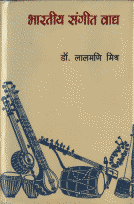Excerpts from
Bharatiya Sangeet Vadya -
Mahati Veena

|
Excerpts from Bharatiya Sangeet Vadya -Mahati Veena |

|
By Dr. Lalmani Misra |

Sudhakalah proclaims in 'Sangeetopnishatsaroddhar', - 'Mahati naradasya cha' when describing forms of Veena. This phrase means that Veena of Narad is Mahati. Not only does Nanyadev affirm this fact, but in his 'Bharat Bhashya', gives a brief introduction of the instrument as well. The description informs that twentry one strings are tuned across three octaves. All three Gram-s manifested clearly on this Veena along with twenty one Moorchchhana-s. .
" Trigram swarsankhyabhistantribhirmahtitiya |
Narado vadakastasya naparo divi vishrutah ||
Atra vyaktastrayo gramah sphutah saptaswara api |
Pratiswaram pratigramam cha moorchchhanastvekvinshatih || (Bharat Bhashya , [manuscipt]
This description of Mahati Veena that Nanyadev has given, is very close to that of Mattakokila. Acharya Shrarangdev in his Sangita Ratnakara, has described Mattakokila in a similar fashion.
The name - Mahati Veena ' finds mention in several treatises like Sangeet Makrand, Sangeetopnishatsaroddhar, Abhidan Chintamani etc. It is remarkable to note that works that mention Mattakokila, do not name Mahati Veena and those that name or describe Mahati Veena do not mention Mattakokila. As the number of strings in both are same in most descriptions, it is safe to assume that very likely these two names apply to same instrument.
Mahati is considered to be Narad's Veena. Narad, it is agreed, was a singer. If we accede to assumption that he would strum or play Veena as he sang, then the argument that Mattakokila was also called Mahati Veena, would appear still more credible. It is firmly established by Kallinath's statement in Kalanidhi that in local parlance, Mattakokila is known as Swarmandal. 1.
Mattakokilaiv loko swarmandalamityuchyate
Rana Kumbha too makes the same assumption. Even today Swarmandal is used by singers as accompaniment. There should be little hesitation in affirming that the use of Swarmandal to accompany singing is a well-known tradition in medieval and contemporary India.
There is little evidence in classical works to substantiate that the instrument treasured in Kolkata museum is Mahati Veena. Several contemporary scholars have accepted it thus but it is a deviant form of Laghu Kinnari Veena and not Mahati Veena.
References :
1 Kalanidhi.[Sangeet Ratnakar Teeka] p.248
Dr. Lalmani Misra on Wikipedia
Excerpts from Bharatiya Sangeet Vadya - Sitar
Excerpts from Bharatiya Sangeet Vadya - Swar-Mandal
Excerpts from Bharatiya Sangeet Vadya - Ektantri Veena
Excerpts from Bharatiya Sangeet Vadya - Brahma Veena
Excerpts from Bharatiya Sangeet Vadya - Elements of Music
Excerpts from Bharatiya Sangeet Vadya - Elements of Music part II
Excerpts from Bharatiya Sangeet Vadya - Swar in Samveda
Excerpts from Bharatiya Sangeet Vadya - Other Veena-s
Bharatiya Sangeet Vadya 1973. Second edition, 2002. pp109-110
published by
Bharatiya Jnanpith
18, Institutional Area, Lodhi Rd
New Delhi - 110003